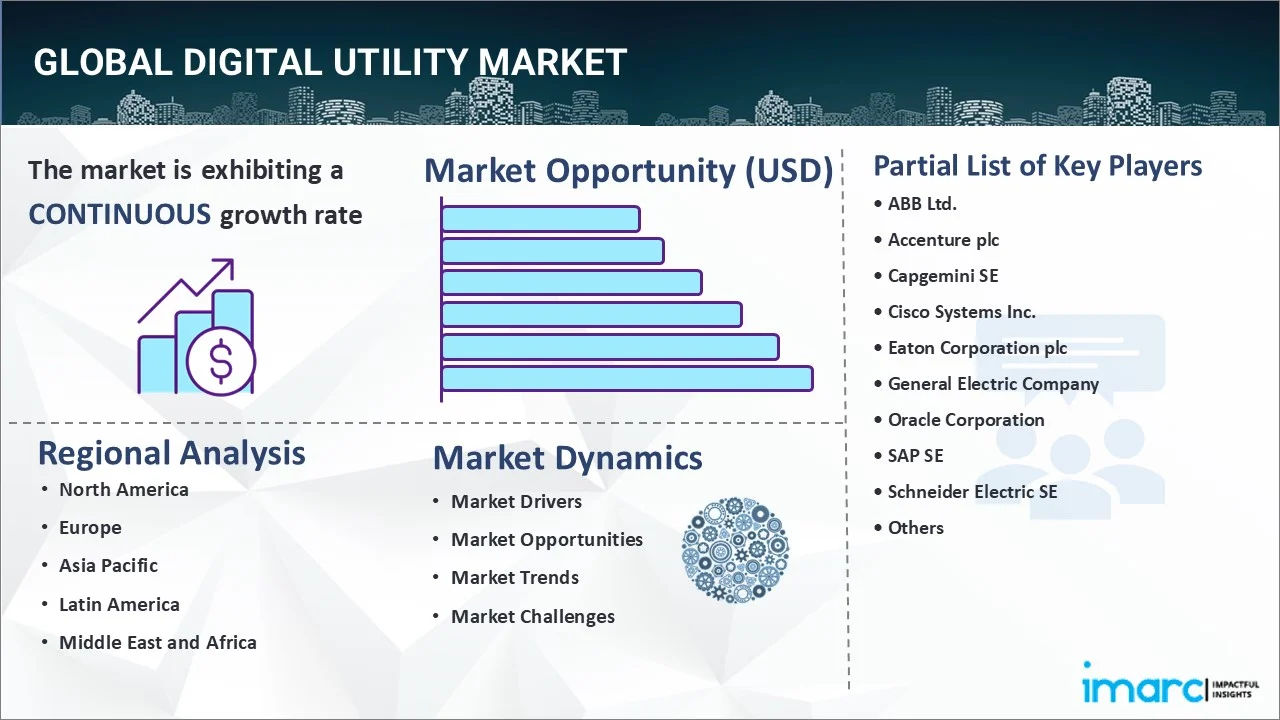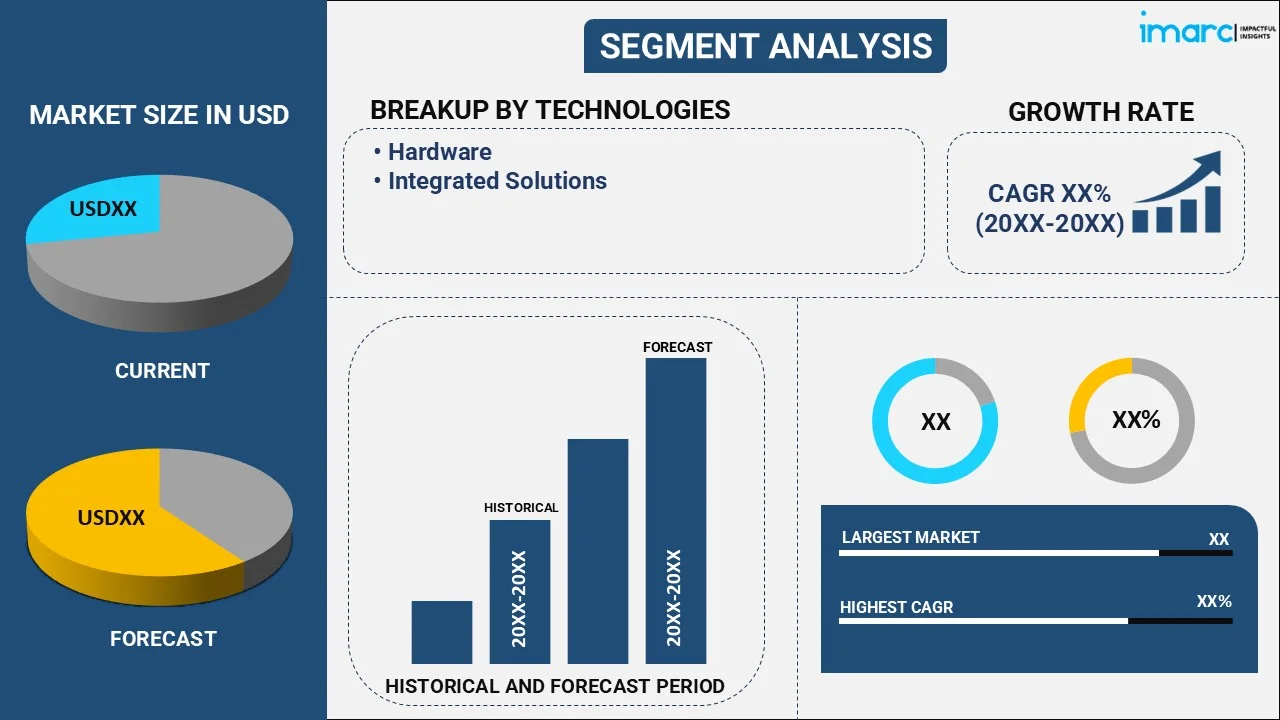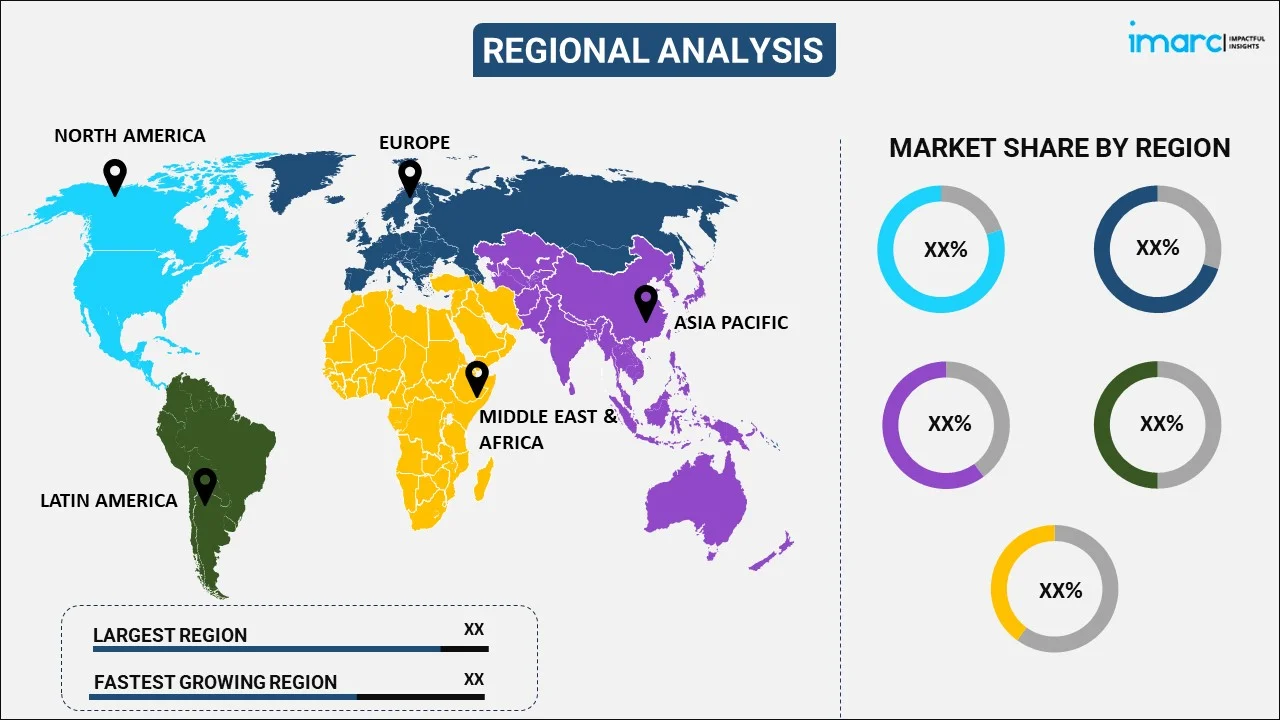
Digital Utility Market Report by Technology (Hardware, Integrated Solutions), Network (Power Generation, Transmission and Distribution, Retail), and Region 2025-2033
Market Overview:
The global digital utility market size reached USD 275.2 Billion in 2024. Looking forward, IMARC Group expects the market to reach USD 583.0 Billion by 2033, exhibiting a growth rate (CAGR) of 8% during 2025-2033. The augmenting demand for efficient, sustainable, and customer-centric utility services, continual technological advancements and innovation in digital solutions in the utility industry, and rising economic growth and industrialization in emerging markets are some of the factors that are propelling the market.
|
Report Attribute
|
Key Statistics
|
|---|---|
|
Base Year
|
2024 |
|
Forecast Years
|
2025-2033
|
|
Historical Years
|
2019-2024
|
| Market Size in 2024 | USD 275.2 Billion |
| Market Forecast in 2033 | USD 583.0 Billion |
| Market Growth Rate (2025-2033) |
8%
|
A digital utility represents the implementation of advanced technologies within the utility industry to enhance operations, efficiency, and customer engagement. Incorporating digital channels, advanced analytics, automation, and interconnected systems, the digital utility focuses on the integration of conventional utility infrastructure with innovative digital solutions. Such integration leads to optimized performance, improved sustainability, and an ability to adapt to the changing energy landscape. The key characteristics of digital utility include real-time data processing, remote monitoring, predictive analytics, and intelligent decision-making, which work synergistically. By leveraging technology platforms, digital utility fosters a more responsive and agile operational environment, thereby transforming the traditional utility frameworks into more customer-centric and efficient systems.

To get more information on this market, Request Sample
The global market is majorly driven by the augmenting demand for efficient, sustainable, and customer-centric utility services is driving the worldwide adoption of digital solutions within the utility sector. This demand is particularly fueled by an increase in urbanization, rising consumer expectations, and a growing emphasis on environmental sustainability. In line with this, the integration of smart grids, Internet of Things (IoT) devices, and data analytics is contributing to improved management of energy distribution networks, thereby fueling the market. The market is further driven by the increasing focus on renewable energy sources and their seamless integration into existing utility infrastructures. Moreover, regulatory pressures and governmental support for clean energy initiatives that promote energy efficiency, carbon reduction, and the use of renewable energy sources are further propelling the adoption of digital solutions in the utility sector.
Digital Utility Market Trends/Drivers:
Continual technological advancements and innovation
The constant evolution of technology plays a crucial role in the expansion of the market for digital solutions in the utility industry. Innovations in areas such as artificial intelligence, machine learning, and cloud computing are transforming the way utility providers operate. These technologies enable more intelligent data analysis, predictive maintenance, and dynamic response to changing conditions. For instance, artificial intelligence can be applied to optimize energy distribution, reduce waste, and predict potential system failures before they occur. Machine learning algorithms assist in understanding consumption patterns, leading to more effective demand management and customer service. Cloud computing facilitates seamless collaboration and data sharing across different departments and geographic locations. The integration of these advanced technologies not only enhances operational efficiency but also fosters innovation, opening new avenues for growth and competitiveness. The relentless pursuit of technological excellence positions utility providers to better meet the needs of a rapidly changing world and represents a foundational driver of market expansion.
Global shift towards sustainability and climate goals
The urgent call for sustainability and the global commitment to achieve climate goals are pressing utility providers to rethink their operational strategies. Across the world, governments, organizations, and societies are actively working towards reducing carbon footprints, promoting energy efficiency, and embracing renewable energy sources. The utility sector plays a vital role in these efforts, as energy production and consumption significantly impact environmental sustainability. Digital technologies offer solutions to these challenges by enabling better monitoring, control, and optimization of energy use. For example, smart grids facilitate the integration of renewable energy sources, ensuring a stable and sustainable energy supply. Energy management systems leverage real-time data to promote energy conservation across industrial, commercial, and residential sectors. The alignment of digital solutions with global environmental priorities contributes to a responsible and sustainable energy future, which is a compelling force driving the market.
Rising economic growth and industrialization in emerging markets
The burgeoning economic growth and industrialization in emerging economies present significant opportunities for the utility sector. As these regions continue to urbanize and develop industrially, the demand for reliable, efficient, and interconnected utility services grows proportionally. Modern utilities must meet the challenges of supplying energy to densely populated cities, burgeoning industries, and rapidly expanding infrastructure networks. Digital solutions play an essential role in addressing these challenges by providing intelligent systems capable of managing complex energy demands. The implementation of smart grids, advanced analytics, and automation technologies allows utility providers to ensure a stable energy supply, reduce costs, and improve service quality. Moreover, the unique challenges and opportunities in emerging markets necessitate innovative approaches tailored to local needs and conditions.
Digital Utility Industry Segmentation:
IMARC Group provides an analysis of the key trends in each segment of the global digital utility market report, along with forecasts at the global, regional, and country levels from 2025-2033. Our report has categorized the market based on technology and network.
Breakup by Technology:

- Hardware
- Smart Grids
- Smart Meters
- Transformers
- Integrated Solutions
- Service
- Cloud and Software
Hardware represents the largest market segment
The report has provided a detailed breakup and analysis of the market based on the technology. This includes hardware (smart grids, smart meters, transformers) and integrated solutions (service, cloud and software). According to the report, hardware represented the largest segment.
The key drivers for the hardware segment are the increasing demand for energy efficiency, the need for optimization of power generation and consumption, and the requirement for accurate energy usage data. Technological advancements such as IoT and AI have also paved the way for more sophisticated and efficient hardware.
On the other hand, the key drivers for the integrated solutions segment are the increasing demand for energy efficiency, the need for optimization of power generation and consumption, and the requirement for accurate energy usage data. Technological advancements such as IoT and AI have also paved the way for more sophisticated and efficient hardware.
Breakup by Network:
- Power Generation
- Transmission and Distribution
- Retail
Transmission and distribution accounts for the majority of the market share
The report has provided a detailed breakup and analysis of the market based on the network. This includes power generation, transmission and distribution, and retail. According to the report, transmission and distribution represented the largest segment.
The drivers for digital utility in the power generation segment include the global shift towards renewable energy sources, the need for real-time monitoring and control of generation units, and the demand for predictive maintenance to reduce operational costs and improve reliability.
On the other hand, the key factors driving the transmission and distribution segment are the need for grid modernization, efficient power transmission with minimized losses, and proactive fault detection and resolution. The desire for increased network visibility and control also fuels the adoption of digital technologies.
Furthermore, the major drivers for the retail segment include the desire to improve customer service, provide personalized offers, and the increasing trend towards electric vehicle charging infrastructure.
Breakup by Region:

- North America
- United States
- Canada
- Europe
- Germany
- France
- United Kingdom
- Italy
- Spain
- Others
- Asia Pacific
- China
- Japan
- India
- South Korea
- Australia
- Indonesia
- Others
- Latin America
- Brazil
- Mexico
- Others
- Middle East and Africa
North America exhibits a clear dominance, accounting for the largest digital utility market share
The report has also provided a comprehensive analysis of all the major regional markets, which include North America (the United States and Canada); Europe (Germany, France, the United Kingdom, Italy, Spain, and others); Asia Pacific (China, Japan, India, South Korea, Australia, Indonesia, and others); Latin America (Brazil, Mexico, and others); and the Middle East and Africa.
North America's strong technological infrastructure and ongoing innovation in digital technologies are leading to the implementation of sophisticated digital utility solutions. Also, stringent regulatory requirements regarding energy efficiency, grid modernization, and customer engagement are compelling utility providers to adopt digital solutions to comply with these mandates.
The demand for more personalized and efficient services is rising among consumers, necessitating utilities to adopt digital platforms that provide real-time information and enhanced customer interaction. Additionally, the growing commitment to sustainable energy sources drives utilities to integrate digital systems to manage renewable energy assets effectively.
With the rise in cyber threats, there is an emphasis on securing energy infrastructure, leading to the growth of digital solutions that focus on security and resilience. The integration of smart grid technologies, promoting efficiency, reliability, and sustainability, is prevalent in the region, contributing to the growth of the market. Furthermore, the stable economic growth in North America and the ongoing urbanization trends are increasing the demand for energy, leading utilities to adopt digital technologies to meet these needs efficiently and sustainably.
Competitive Landscape:
The leading companies are investing heavily in R&D to innovate and develop new technologies, tools, and solutions that can offer improved efficiency, functionality, and security in the utility sector. Many key players are forming alliances, partnerships, and joint ventures with other industry players, technology providers, and research institutions. These collaborations enable them to combine resources, knowledge, and expertise to enhance their product offerings and expand their reach. To capture new growth opportunities, major players are exploring and entering emerging markets where the digital transformation in utilities is in the early stages. Companies are also enhancing their customer support services to assist utility companies in implementing and managing digital solutions. This includes providing training, technical support, and consultation to ensure seamless integration and optimization of digital technologies within existing utility infrastructures.
The report has provided a comprehensive analysis of the competitive landscape in the market. Detailed profiles of all major companies have also been provided. Some of the key players in the market include:
- ABB Ltd.
- Accenture plc
- Capgemini SE
- Cisco Systems Inc.
- Eaton Corporation plc
- General Electric Company
- Oracle Corporation
- SAP SE
- Schneider Electric SE
- Siemens AG
Digital Utility Market Report Scope:
| Report Features | Details |
|---|---|
| Base Year of the Analysis | 2024 |
| Historical Period | 2019-2024 |
| Forecast Period | 2025-2033 |
| Units | Billion USD |
| Scope of the Report | Exploration of Historical and Forecast Trends, Industry Catalysts and Challenges, Segment-Wise Historical and Predictive Market Assessment:
|
| Technologies Covered |
|
| Networks Covered | Power Generation, Transmission and Distribution, Retail |
| Regions Covered | Asia Pacific, Europe, North America, Latin America, Middle East and Africa |
| Countries Covered | United States, Canada, Germany, France, United Kingdom, Italy, Spain, China, Japan, India, South Korea, Australia, Indonesia, Brazil, Mexico |
| Companies Covered | ABB Ltd., Accenture plc, Capgemini SE, Cisco Systems Inc., Eaton Corporation plc, General Electric Company, Oracle Corporation, SAP SE, Schneider Electric SE, Siemens AG, etc. |
| Customization Scope | 10% Free Customization |
| Post-Sale Analyst Support | 10-12 Weeks |
| Delivery Format | PDF and Excel through Email (We can also provide the editable version of the report in PPT/Word format on special request) |
Key Questions Answered in This Report:
- How has the global digital utility market performed so far, and how will it perform in the coming years?
- What are the drivers, restraints, and opportunities in the global digital utility market?
- What is the impact of each driver, restraint, and opportunity on the global digital utility market?
- What are the key regional markets?
- Which countries represent the most attractive digital utility market?
- What is the breakup of the market based on the technology?
- Which is the most attractive type in the digital utility market?
- What is the breakup of the market based on the network?
- Which is the most attractive network in the digital utility market?
- What is the competitive structure of the global digital utility market?
- Who are the key players/companies in the global digital utility market?
Key Benefits for Stakeholders:
- IMARC’s report offers a comprehensive quantitative analysis of various market segments, historical and current market trends, market forecasts, and dynamics of the digital utility market from 2019-2033.
- The research study provides the latest information on the market drivers, challenges, and opportunities in the global digital utility market.
- The study maps the leading, as well as the fastest-growing, regional markets. It further enables stakeholders to identify the key country-level markets within each region.
- Porter's five forces analysis assist stakeholders in assessing the impact of new entrants, competitive rivalry, supplier power, buyer power, and the threat of substitution. It helps stakeholders to analyze the level of competition within the digital utility industry and its attractiveness.
- Competitive landscape allows stakeholders to understand their competitive environment and provides an insight into the current positions of key players in the market.
Need more help?
- Speak to our experienced analysts for insights on the current market scenarios.
- Include additional segments and countries to customize the report as per your requirement.
- Gain an unparalleled competitive advantage in your domain by understanding how to utilize the report and positively impacting your operations and revenue.
- For further assistance, please connect with our analysts.
 Request Customization
Request Customization
 Speak to an Analyst
Speak to an Analyst
 Request Brochure
Request Brochure
 Inquire Before Buying
Inquire Before Buying




.webp)




.webp)












